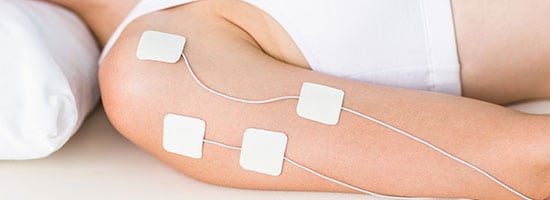
The sensation of pain is created by signals traveling from nerves to the brain. Those signals are interpreted as pain that can range from mild to debilitating. If medication and physical therapy alone aren’t providing significant pain relief, electrotherapy that primarily targets nerves transmitting pain signals may be recommended. It’s a therapeutic treatment frequently used by patients with lower back pain, although various forms of electrotherapy are also used for persistent discomfort affecting other parts of the body.
What Is Electrotherapy?
Electrotherapy refers to a group of several specific treatments that ease pain by stimulating tissue repair and healing, promoting bone growth, improving circulation, and increasing muscle strength. These treatments use small electrical impulses to stimulate tissues for therapeutic purposes.
How Does It Work?
Electrotherapy works by delivering low levels of electricity with a special battery powered device. Electrical impulses are transmitted via wires and electrode pads placed over skin in the affected area. Patients control the level of stimulation with a handheld device. Newer devices work with a single unit without wires.
When to Consider Electrotherapy
Not typically a standalone remedy, electrotherapy is often combined with other forms of pain management. It’s sometimes recommended when traditional attempts at pain relief aren’t effective. It’s also an option worth considering for some patients looking to put off or avoid non-urgent spine surgery. Relief experienced may also make it possible for patients to ease their reliance on opiates and other medications for chronic pain control.
TENS Units for Pain Management
The most common type of electrotherapy is transcutaneous electrical nerve stimulation (TENS), which has been a pain management option since the 1960s. When in use, the device produces mild tingling sensations in the area where the electrodes are attached that reduces the sensation of pain. The control unit allows for a wide range of stimulation levels. In addition to low back pain, TENS units may be recommended for patients with:
- Neck pain and stiffness
- Diabetic nerve pain
- Fibromyalgia pain
Other Forms of Electrotherapy
Percutaneous electrical nerve stimulation (PENS) involves the use of small needles that go through the skin. Current is delivered closer to nerves with PENS to reduce sensitivity to pain. Electrical muscle stimulation (EMS) targets muscles instead of nerves. Pulsed electromagnetic field therapy (PEMF) is sometimes used on patients who have had fusion surgery to promote tissue growth and help the fusion form.
Possible side effects of electrotherapy are generally mild. It’s an appealing pain management technique or many patients since it allows the user to determine how much stimulation is appropriate at any given time. The relief experienced with electrotherapy sometimes allows patients to increase their participation in physical therapy routines, which can increase the strength of muscles that directly or indirectly support bones and joints in the affected area.


